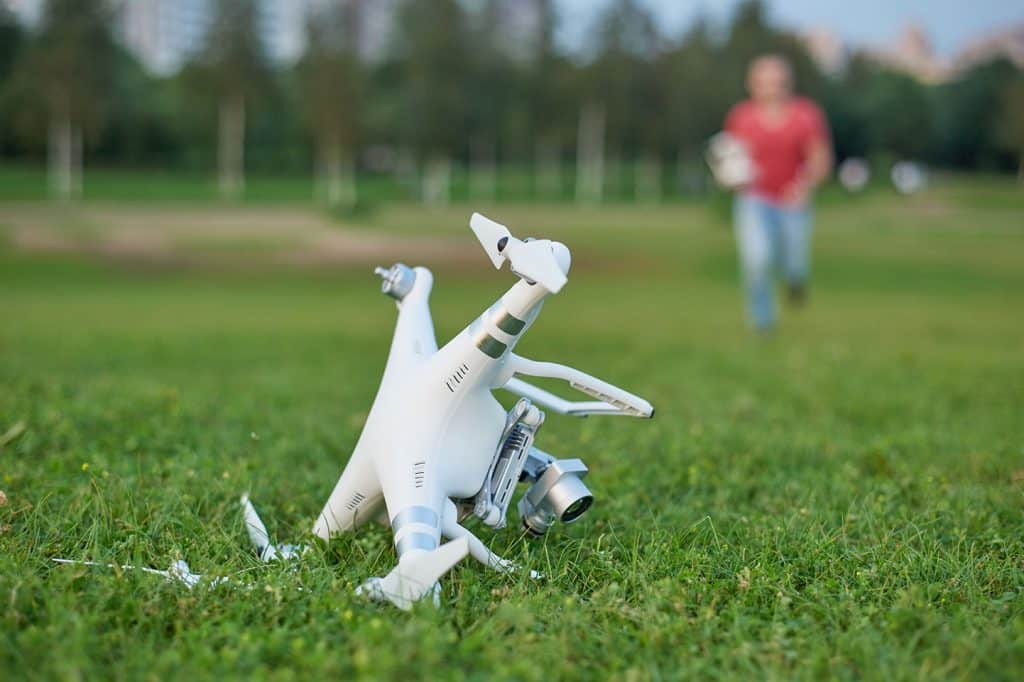
When it comes to flying a drone, there are some factors that are inevitably out of your hands which could cause your drone to crash. However, there are some factors that can be easily avoided if you are aware of them. Below we have outlined ten reasons why drones can crash and how to avoid it happening:
-
Malfunctioning Rotors
The rotors/propellers of your drone are made to be sturdy, yet soft so as not to hurt people or cause damage to other objects. They are thus quite susceptible to bending out of shape after several bumps. Therefore, always check each of the rotors before a flight to make sure they are in perfect shape.
-
No GPS Signal
If you are flying your UAV indoors, you are almost guaranteed to lack GPS signal. It is therefore recommended to always fly in open areas away from tall buildings whenever you can.
-
Compass Error
Incorrectly tuned compasses are one of the biggest causes of drone crashes. Drone compasses can become detuned from any magnetic and radio frequency source. Avoid keeping the UAV is too close to magnets such as those in car speakers during transportation as well as flying in an environment with high electromagnetic interference, such as close to high voltage power lines and mobile towers.
-
Disconnected Video Transmission
This is another common cause of drone crashes and can happen at any time from your first flight to some months later, usually arising from loose cables and damaged ports. Make sure your cables are always well plugged in before flight and unplugged carefully after, to keep the ports in good shape.
-
Hitting Return To Home Too Soon
When you lose control of your drone, as a pilot one of the quickest natural reactions would be to hit the Return to Home (RTH) button. However, it is worth keeping in mind that most consumer drones can’t avoid obstacles. This means the UAV will simply trace a straight line to the home point even if there are trees or buildings or electricity poles in the way which can easily result in a serious crash. Therefore, stay calm and figure out a better move before pressing the RTH button.
-
Incorrect Home Point
This sometimes happens when the GPS lock is lost during flight and then regained causing the drone to recalibrate an incorrect home point. Keep in mind that the home point can be where your UAV took off from or wherever your remote controller is, so ensure that it is correct. Finally, make sure that you set your return home altitude so that it’s higher than anything in the area, 100 meters should work fine unless you’re flying in a city or near some particularly tall structures such as telephone masts.
-
Power Failure
It is key to always fly with a fully charged battery and never be tempted to start a new flight with a low or partially charged battery. While you’ll probably get away with using a semi-charged batter most of the time, this always comes with the risk of randomly losing power mid flight when you least expect it.
-
Insufficient Battery To Return Home Safely
It is important to land your drone with 30% power in reserve such that in case an emergency requires you to delay the landing you have enough time to either find a new landing spot or deal with the problem. Furthermore, some UAV’s come with a failsafe feature where the drone automatically heads for its home point once the battery reaches 10% and whilst this can be useful, if there any trees or other obstacles between the drone and its home point it will fly straight into them.
-
Crashing Into Another Drone
If there are other UAVs in the sky there is always the possibility of a collision especially if the pilots are both unaware of each other’s presence in the area, performing complex flight manoeuvres or racing. By logging your flight via the Coverdrone FlySafe App, your flight will be visible to other pilots flying within the same area, which could reduce the risk of a collision.
-
Mistaking The Direction Of The Aircraft
When the drone is flying so high up in the sky it can be hard to tell, especially for the beginner pilots, which side is which and so you may easily mistake the tail end for the nose and hence misdirect the UAV. Make sure to familiarise yourself with which side is which before flying farther out.
